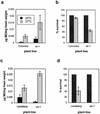Protection against heat stress-induced oxidative damage in Arabidopsis involves calcium, abscisic acid, ethylene, and salicylic acid
- PMID: 11842171
- PMCID: PMC148929
- DOI: 10.1104/pp.010320
Protection against heat stress-induced oxidative damage in Arabidopsis involves calcium, abscisic acid, ethylene, and salicylic acid
Abstract
Plants, in common with all organisms, have evolved mechanisms to cope with the problems caused by high temperatures. We examined specifically the involvement of calcium, abscisic acid (ABA), ethylene, and salicylic acid (SA) in the protection against heat-induced oxidative damage in Arabidopsis. Heat caused increased thiobarbituric acid reactive substance levels (an indicator of oxidative damage to membranes) and reduced survival. Both effects required light and were reduced in plants that had acquired thermotolerance through a mild heat pretreatment. Calcium channel blockers and calmodulin inhibitors increased these effects of heating and added calcium reversed them, implying that protection against heat-induced oxidative damage in Arabidopsis requires calcium and calmodulin. Similar to calcium, SA, 1-aminocyclopropane-1-carboxylic acid (a precursor to ethylene), and ABA added to plants protected them from heat-induced oxidative damage. In addition, the ethylene-insensitive mutant etr-1, the ABA-insensitive mutant abi-1, and a transgenic line expressing nahG (consequently inhibited in SA production) showed increased susceptibility to heat. These data suggest that protection against heat-induced oxidative damage in Arabidopsis also involves ethylene, ABA, and SA. Real time measurements of cytosolic calcium levels during heating in Arabidopsis detected no increases in response to heat per se, but showed transient elevations in response to recovery from heating. The magnitude of these calcium peaks was greater in thermotolerant plants, implying that these calcium signals might play a role in mediating the effects of acquired thermotolerance. Calcium channel blockers and calmodulin inhibitors added solely during the recovery phase suggest that this role for calcium is in protecting against oxidative damage specifically during/after recovery.
Figures







References
-
- Annamalai P, Yanaghiara S. Identification and characterization of a heat stress induced gene in cabbage encodes a kunitz type protease inhibitor. J Plant Physiol. 1999;155:226–233.
-
- Burke JJ. Identification of genetic diversity and mutations in higher plant acquired thermotolerance. Physiol Plant. 2001;112:167–170.
-
- Campbell AK, Trewavas AJ, Knight MR. Calcium imaging shows differential sensitivity to cooling and communication in luminous transgenic plants. Cell Calcium. 1996;19:211–218. - PubMed
Publication types
MeSH terms
Substances
LinkOut - more resources
Full Text Sources
Other Literature Sources
Molecular Biology Databases

